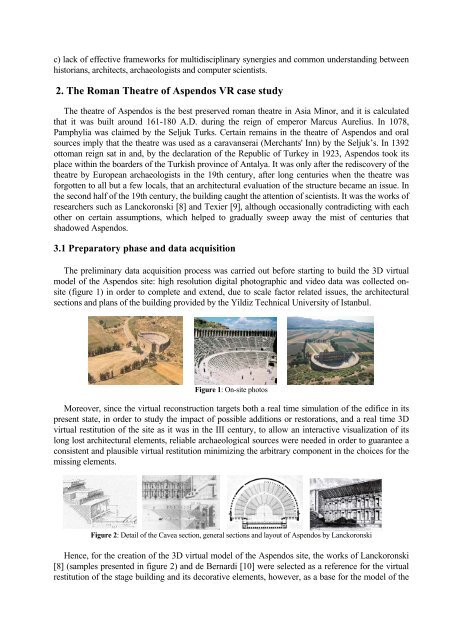ERATO Proceedings Istanbul 2006.pdf - Odeon
ERATO Proceedings Istanbul 2006.pdf - Odeon
ERATO Proceedings Istanbul 2006.pdf - Odeon
You also want an ePaper? Increase the reach of your titles
YUMPU automatically turns print PDFs into web optimized ePapers that Google loves.
c) lack of effective frameworks for multidisciplinary synergies and common understanding between<br />
historians, architects, archaeologists and computer scientists.<br />
2. The Roman Theatre of Aspendos VR case study<br />
The theatre of Aspendos is the best preserved roman theatre in Asia Minor, and it is calculated<br />
that it was built around 161-180 A.D. during the reign of emperor Marcus Aurelius. In 1078,<br />
Pamphylia was claimed by the Seljuk Turks. Certain remains in the theatre of Aspendos and oral<br />
sources imply that the theatre was used as a caravanserai (Merchants' Inn) by the Seljuk’s. In 1392<br />
ottoman reign sat in and, by the declaration of the Republic of Turkey in 1923, Aspendos took its<br />
place within the boarders of the Turkish province of Antalya. It was only after the rediscovery of the<br />
theatre by European archaeologists in the 19th century, after long centuries when the theatre was<br />
forgotten to all but a few locals, that an architectural evaluation of the structure became an issue. In<br />
the second half of the 19th century, the building caught the attention of scientists. It was the works of<br />
researchers such as Lanckoronski [8] and Texier [9], although occasionally contradicting with each<br />
other on certain assumptions, which helped to gradually sweep away the mist of centuries that<br />
shadowed Aspendos.<br />
3.1 Preparatory phase and data acquisition<br />
The preliminary data acquisition process was carried out before starting to build the 3D virtual<br />
model of the Aspendos site: high resolution digital photographic and video data was collected onsite<br />
(figure 1) in order to complete and extend, due to scale factor related issues, the architectural<br />
sections and plans of the building provided by the Yildiz Technical University of <strong>Istanbul</strong>.<br />
Figure 1: On-site photos<br />
Moreover, since the virtual reconstruction targets both a real time simulation of the edifice in its<br />
present state, in order to study the impact of possible additions or restorations, and a real time 3D<br />
virtual restitution of the site as it was in the III century, to allow an interactive visualization of its<br />
long lost architectural elements, reliable archaeological sources were needed in order to guarantee a<br />
consistent and plausible virtual restitution minimizing the arbitrary component in the choices for the<br />
missing elements.<br />
Figure 2: Detail of the Cavea section, general sections and layout of Aspendos by Lanckoronski<br />
Hence, for the creation of the 3D virtual model of the Aspendos site, the works of Lanckoronski<br />
[8] (samples presented in figure 2) and de Bernardi [10] were selected as a reference for the virtual<br />
restitution of the stage building and its decorative elements, however, as a base for the model of the
















